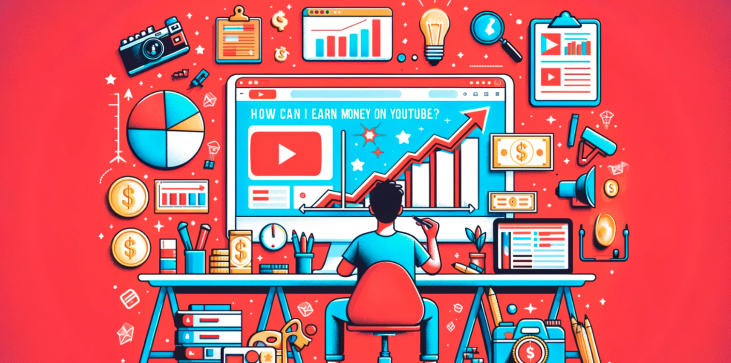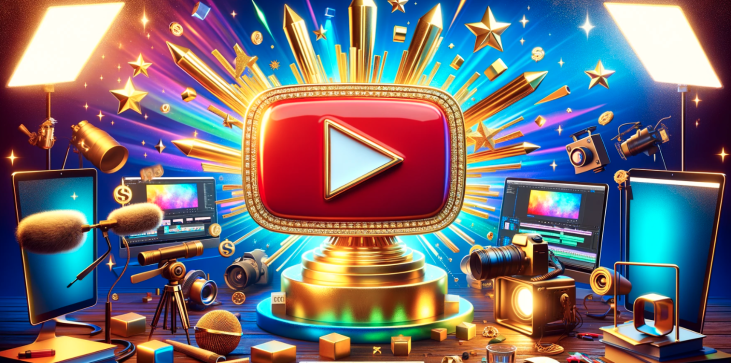
When I first considered the idea of earning income on YouTube, I was intrigued by the seemingly endless possibilities the platform offered. Not only has YouTube become a staple in entertainment and education, but it is also a lucrative field for content creators around the globe. My initial foray into the YouTube landscape was filled with curiosity and a bit of skepticism. Could I really turn my passion for creating videos into a tangible income source? As I delved deeper into the world of YouTube, I discovered that with the right approach, dedication, and strategies, the answer was a resounding yes. Making money on YouTube isn't just about hitting 'upload' and waiting for the dollars to roll in. It requires understanding the platform, knowing your audience, and leveraging the various monetization options available. From ad revenue to sponsored content, the potential to earn is only limited by one's creativity and effort. In this guide, I'll share my journey and insights into how to make money on YouTube, from the basics of monetization to the strategies that can boost your views and subscriber count. Before diving into the specifics, it's critical to note that YouTube isn't a get-rich-quick scheme. It takes time to build a channel, craft quality content, and attract a loyal audience. But with persistence and the right guidance, I found that YouTube could be a sustainable source of income. Let's explore how you can do the same.
Understanding the framework of YouTube monetization was the first step in my journey. YouTube offers content creators several ways to earn money, most notably through the YouTube Partner Program (YPP). The YPP allows creators to monetize their videos through ads, channel memberships, super chats, and more. However, to be eligible for the program, certain criteria must be met, including a minimum number of subscribers and watch hours.
The primary source of income for most YouTubers is ad revenue. When you enable monetization on your channel, YouTube places ads in your videos, and you earn a share of the revenue generated from these ads. This revenue is dependent on several factors, such as the number of views your videos receive, the engagement they garner, and the demographics of your audience. Advertisers are willing to pay more to target certain audiences, which can affect how much you earn from ad revenue.
Another key aspect of YouTube monetization is the type of content you create. YouTube has strict guidelines on what is considered 'advertiser-friendly' content. Videos that do not adhere to these guidelines may be demonetized or earn less from ads. Therefore, it's important to create content that is not only engaging but also aligns with YouTube's monetization policies. As I learned more about these intricacies, I realized that a successful YouTube channel requires a strategic approach to content creation and audience engagement.
One of the most common questions I encountered on my journey was, "How many views on YouTube to make money?" The answer is not straightforward, as earnings from views can vary greatly. However, generally speaking, more views equate to more potential earnings. The YouTube Partner Program requires creators to have at least 1,000 subscribers and a minimum of 4,000 watch hours over the past 12 months to start earning through ads.
As for the question of "How many subscribers do you need to make money on YouTube?" the same threshold applies. Having 1,000 subscribers is the gateway to joining the YPP and starting to monetize your videos. But it's not just about hitting these numbers. Engagement, such as likes, comments, and shares, also plays a significant role in your earning potential. Advertisers favor channels with high engagement rates as it indicates an active and invested audience.
The notion of "how much subscribers on YouTube to make money" is slightly misleading, as subscribers alone do not generate income. It's the combination of a substantial subscriber base and consistent viewership that creates opportunities for monetization. The more subscribers you have, the more likely you are to have a higher number of views, which can lead to increased ad revenue and other monetization prospects. Building a large and dedicated subscriber base is essential for long-term financial success on YouTube.
To enhance my channel's earning potential, I needed to implement strategies to increase my views and subscribers. The first strategy I focused on was creating high-quality, engaging content. This seems like a no-brainer, but it's the foundation of any successful YouTube channel. I invested in better equipment, learned video editing techniques, and researched topics that resonated with my target audience. By consistently providing value and entertainment, I began to see an uptick in both views and subscriber numbers.
Another effective strategy is optimizing video titles, descriptions, and tags for search engine visibility. YouTube is the second largest search engine in the world, and optimizing my content for discoverability was crucial. I used relevant keywords in my titles and descriptions, crafted compelling thumbnails, and utilized tags that helped my videos appear in search results and recommended video sections. SEO played a significant role in attracting new viewers who could then become subscribers.
Collaborations with other YouTubers also helped boost my viewership and subscriber count. By partnering with creators in my niche, I tapped into their audiences and gained exposure to potential subscribers. Additionally, engaging with my viewers through comments and community posts created a sense of community around my channel, encouraging viewers to subscribe and stay for more content. These strategies, among others, propelled my channel's growth and, as a result, my earnings.
YouTube monetization is not limited to ad revenue. There are myriad ways to diversify income streams on the platform. One such method is through channel memberships, where subscribers pay a monthly fee for access to exclusive content, badges, and other perks. This recurring revenue can be a stable source of income, especially for channels with a dedicated fan base.
Affiliate marketing is another avenue I explored to make money on YouTube. By promoting products or services and including affiliate links in my video descriptions, I earned a commission for every sale made through my links. This method works well when the products align with my content and audience interests, ensuring authenticity and trust.
Merchandising is also a lucrative option for YouTubers with a strong brand identity. Selling branded merchandise, such as clothing, accessories, or digital products, can significantly boost earnings. Setting up an online store and promoting my merchandise in my videos allowed me to tap into my audience's loyalty and turn it into a profitable venture.
Surprisingly, it's possible to learn how to make money on YouTube without making videos. One method is by curating content. This involves creating playlists or compilations of existing YouTube videos (with permission) and monetizing them. However, this approach requires careful adherence to copyright laws to avoid any legal issues.
Another way is to become a YouTube channel manager for other creators. Many successful YouTubers need help managing their channels, from optimizing content for SEO to handling sponsorships and emails. By offering these services, I could earn income from YouTube without producing my own videos.
Additionally, YouTube's Super Chat and Super Stickers features allow viewers to pay to highlight their messages during live streams, even if I'm not the one streaming. If I have a popular YouTube community or forum, hosting live Q&A sessions and discussions can generate income through these features, without the need for traditional video content.

Achieving success in YouTube monetization requires more than just understanding the various revenue streams. It's about adopting a strategic and consistent approach to content creation and community engagement. One tip that served me well is always staying informed about YouTube's algorithm changes and monetization policies. Keeping abreast of these updates allowed me to adapt my strategy and remain compliant, ensuring a steady income flow.
Another important tip is to analyze and understand my audience. Using YouTube's analytics tools, I gained insights into who my viewers are, what content they enjoy, and when they are most active. This data helped me tailor my content and posting schedule to maximize engagement and reach.
Lastly, never underestimate the power of a call to action (CTA). Encouraging viewers to like, subscribe, and share my videos in a compelling way can significantly increase visibility and growth. A strong CTA can be the difference between a viewer watching and leaving or becoming a loyal subscriber and advocate for my channel.
To truly grasp the potential of YouTube monetization, it's helpful to examine real-life success stories. I've studied several case studies of YouTubers who have turned their channels into profitable businesses. These creators come from diverse backgrounds and niches, yet they share common traits such as consistency, adaptability, and a deep understanding of their audience.
One particular case study that inspired me was a YouTuber who started with simple how-to videos in a specific niche. By focusing on quality content and SEO, they grew their subscriber base to over a million within a couple of years. They diversified their income through ad revenue, sponsorships, and merchandise, eventually turning their YouTube channel into a full-time career.
Another case study highlighted a creator who utilized the power of viral content. By creating videos that tapped into current trends and leveraging social media for promotion, they amassed millions of views and a surge in subscribers. This increased visibility attracted brand deals and opened up opportunities for paid speaking engagements and consultations.
These case studies demonstrate that with the right approach, YouTube monetization can be a viable and rewarding endeavor. They serve as a reminder that success on the platform is attainable with hard work and smart strategies.
To maximize my YouTube earnings, I utilized a variety of tools and resources designed to optimize my channel's performance. TubeBuddy and VidIQ are two popular browser extensions that provide valuable insights into SEO, suggested tags, and best posting times. These tools helped me optimize my videos for better search visibility and engagement.
YouTube's own Creator Academy is an invaluable resource for learning about monetization strategies, content creation, and growing a channel. The lessons and tutorials provided by the Academy were instrumental in refining my approach to YouTube monetization.
Additionally, social media management tools like Hootsuite and Buffer allowed me to schedule posts and track engagement across platforms, amplifying my content's reach. Networking with other creators and joining YouTube communities also provided support and insights into best practices for monetization.
Learning how to make money on YouTube has been a rewarding journey, filled with challenges and triumphs. From understanding monetization basics to implementing advanced strategies, the potential for earning on the platform is vast. Remember, success on YouTube is not solely measured by the number of views or subscribers, but by the quality of the connection you build with your audience.
Whether you're just starting out or looking to enhance your existing channel, I hope this guide has provided you with valuable insights and inspiration. With dedication, creativity, and the right tools, you too can turn your YouTube channel into a profitable venture. Continue to learn, adapt, and grow, and you'll find that the opportunities on YouTube are as limitless as your imagination.
YouTubers make money through various monetization strategies, including:
To monetize your YouTube channel through the Partner Program and start earning ad revenue, you need to meet certain eligibility requirements set by YouTube. As of 2022, these requirements include:
Yes, there are several alternative ways to make money on YouTube besides ad revenue. These include: